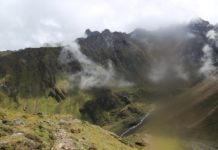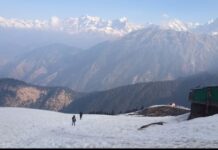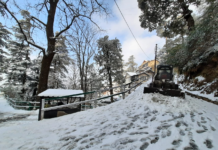Mountains are the most magnificent and majestic geographical features of the world. Be it the Andes in South America, the Alps in Europe or the mighty Himalayas in Asia, mountains provide the necessary support to biodiversity, culture, economics and social milieu of the region. Mountains cover around 27 per cent of the total geographical area of the world. They are not only critical for a particular part but the entire ecosystem of the planet.
I consider myself very fortunate that I was born in the lap of Himalayas- the abode of snow. In Indian culture, the Himalayas are the symbol of confidence, stability, steadiness, firmness and fearlessness. My pen name “Nishank” is also inspired by the spirit of Himalayas. As we celebrate the International Mountain Day 2020 whose theme is mountain biodiversity, I would like to focus on the Himalayas, which is also known as the water tower of Asia.
The Himalayas are not merely a mountain range; they are a treasure trove of biodiversity, spirituality, culture, diversity and resources. It is perhaps the only mountain range in the world where science and spirituality interact so spellbindingly and closely. It is the first school of environmental studies. The diversity of flora and fauna that flourishes here is enormous. The Indian Himalayan Region (IHR) hosts a magnanimous number of birds, mammals, migratory birds, reptiles and amphibians. Out of the total vertebrate diversity of the country, 27.6 per cent exists in the
IHR.
From baba Badri-Kedar to baba Barfani it is composed of celestial chords which profoundly touch the human heart and spirit. The alluring spiritual beauty of the Himalayas is much more mesmerising than its stunning natural beauty. The socio-cultural diversity it provides is also prolific. We have so many tribes supported by the Himalayan zone, from Bakarwal in Kashmir to Apatani in mystical Ziro valley of Arunachal, it preserves the rich heritage, music, dance forms, art-forms, belief systems and around 740 dialects.
We can trace the genesis of holy Vedas, Upanishads and Puranas to the Himalayas. Indian medicine system of Ayurveda and calculus of yoga, which purifies and cures the body, mind and spirit and goes beyond physical and metaphysical, originated in the heights of Himalayas. The Himalayas have been inspiring humankind for ages. There is a school of thought which believes that the shape of the Himalayan range inspired the triangular shape of the Garbhagraha of various temple architectures. It is treated like a god, as it has so much to give, from the water of ten river systems to the plants of significantly high medicinal values and as a climate buffer for the entire subcontinent, which defines the economy of the region. Also, The Himalayas are the epicenter of the geopolitics of the Indian subcontinent. The passes in the sector and terrain provide it with a great strategic significance.
Mountains across the globe are facing challenges due to climate change, over-exploitation, forest fires, and human migration. Scientific shreds of evidence are there which reports that around 67 per cent glaciers of the IHR are retreating. The paani and jawani of the Himalayan region should be used optimally for the benefit of the region.
The rugged and challenging terrain of Himalayas train the human resource to be more alert, active and attentive, these qualities are naturally part of the people from the region. The youth also have an indomitable will, bravery and courage like that of the Himalayas in their personalities. No wonder that thousands of people from this part are serving the motherland at the borders. When someone asked our beloved Prime Minister Narendra Modi about handling the extreme conditions and hardships, he said that “the strength that I gained after my stay in the Himalayas is still within me. I met people who believed in minimalist living and leaving no carbon footprints.”
The Government of India under the leadership of Prime Minister Modi is committed to conserve, preserve and strengthen the Himalayan ecosystem and biodiversity. In 2014, during the maiden budget, the Modi government allocated Rs 100 crore to establish a centre for Himalayan studies in Uttarakhand, this shows that the territory is the priority of the current government.
Also, to sustain and safeguard the Himalayan ecosystem and glaciers, National Mission for Sustaining Himalayan Ecosystem (NMSHE) is one of the missions under the National Action Plan on Climate Change (NAPCC). Apart from this NITI Aayog in 2017 made five working groups to address the critical challenges of the Indian Himalayan region that spreads over 11 states and two UTs. These groups made crucial observations and suggested far-reaching recommendations on areas of agriculture, water security, capacity building, data and information management, sustainable tourism in the Himalayan region. There have been debates about the green bonus for Himalayan states and separate ministry to deal with the issue of the Himalayan states. Himalaya is one of the thrust areas of the government of the day. Mission mode projects like Namami Gange or Char Dham programme are going on to provide support to the Himalayan ecosystem. There are many laudable initiatives by the government for skill development, economic empowerment, heritage conservation, energy management, tourism and infrastructure development (railway lines, bridges, roads) across the Himalayan belt.
I have been advocating about the rights, issues and challenges of Himalayan states in various platforms in my personal and public life. Through my thoughts, writings and actions, I am committed to the cause of a sustainable Himalaya. I believe that better use of technology and 21st-century digital tools of AI/ML, data analytics and image processing backed by bottom-up collaborations (Himalayan Panchayats) between Himalayan states can aid us to a great extent. We may also initiate active and long-term political and academic international partnerships for the Himalayas and Himalayan glacial ecosystems.
I am sure that the leadership our Prime Minister is providing will surely take us to the summit of sustainable Himalayas.
(The writer is the Union Education minister)





















